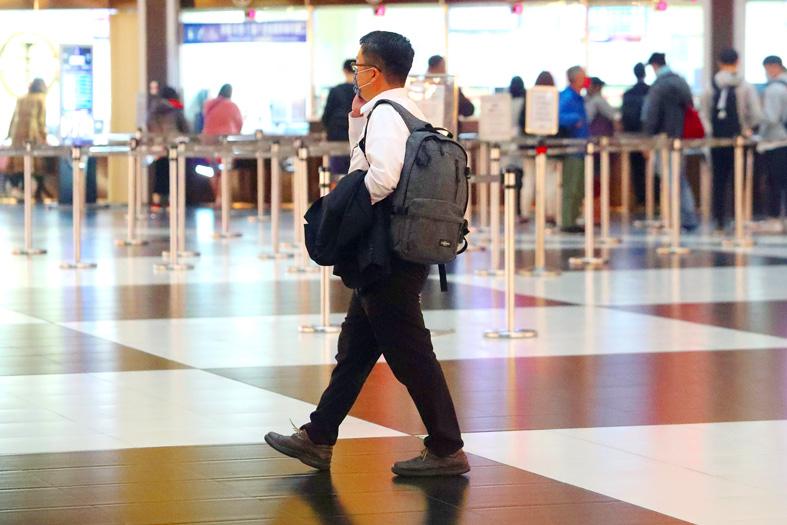The nation’s unemployment rate last month improved to 3.67 percent, 0.03 percentage points lower than a month earlier, as the job market remained stable and hiring recovered to near pre-COVID-19-pandemic levels, the Directorate-General of Budget, Accounting and Statistics (DGBAS) said yesterday.
“The market is stable with fewer unemployed and more jobs,” DGBAS Deputy Director Chen Hui-hsin (陳惠欣) said.
In February, the government’s business climate monitor was “red,” suggesting an economic boom.

Photo: CNA
The unemployment reading after seasonal adjustments was 3.72 percent, the lowest in 13 months, Chen said, adding that the figures should fall further this month and next before graduates enter the job market in the summer.
Still, the number of employed last quarter was down 3,000 compared with the same period last year, indicating that the negative effects of the pandemic remain and a low birthrate might also contribute to the drop, she said.
There were 439,000 unemployed last month, a decrease of 4,000 from a month earlier, the DGBAS report showed.
The number of people who lost their jobs to downsizing or closures fell by 3,000 and the number of first-time jobseekers dropped by 2,000, it said.
However, the number of people who quit their jobs increased by 2,000.
It took people longer to find jobs as the unemployment period extended 0.3 weeks to 22.7 weeks, it said, adding that first-time jobseekers averaged a 26-week wait to find work.
The number of people who were out of work for longer than a year grew by 4,000 to 55,000, it said.
The highest unemployment rate was among people with university degrees at 5.37 percent, followed by high-school graduates at 3.37 percent, while people with graduate degrees were unchanged at 2.84 percent, the agency said.
People with an education level of junior-high school or lower had the lowest unemployment rate of 2.53 percent, followed by those with a junior college education at 2.57 percent, it said.
People aged 20 to 24 had the highest unemployment rate at 11.85 percent, followed by those aged 15 to 19 at 8.48 percent, 25 to 29 at 6.27 percent and 30 to 34 at 3.63 percent, DGBAS said.
People aged 45 to 64 had the lowest unemployment rate at 2.12 percent, it said.
The nation’s headline unemployment rate of 3.67 percent is higher than Japan’s 2.8 percent, but lower than South Korea’s 4.3 percent, Germany’s 4.6 percent and Hong Kong’s 6.8 percent, it added.

TAKING STOCK: A Taiwanese cookware firm in Vietnam urged customers to assess inventory or place orders early so shipments can reach the US while tariffs are paused Taiwanese businesses in Vietnam are exploring alternatives after the White House imposed a 46 percent import duty on Vietnamese goods, following US President Donald Trump’s announcement of “reciprocal” tariffs on the US’ trading partners. Lo Shih-liang (羅世良), chairman of Brico Industry Co (裕茂工業), a Taiwanese company that manufactures cast iron cookware and stove components in Vietnam, said that more than 40 percent of his business was tied to the US market, describing the constant US policy shifts as an emotional roller coaster. “I work during the day and stay up all night watching the news. I’ve been following US news until 3am

Six years ago, LVMH’s billionaire CEO Bernard Arnault and US President Donald Trump cut the blue ribbon on a factory in rural Texas that would make designer handbags for Louis Vuitton, one of the world’s best-known luxury brands. However, since the high-profile opening, the factory has faced a host of problems limiting production, 11 former Louis Vuitton employees said. The site has consistently ranked among the worst-performing for Louis Vuitton globally, “significantly” underperforming other facilities, said three former Louis Vuitton workers and a senior industry source, who cited internal rankings shared with staff. The plant’s problems — which have not

UNCERTAINTY: Innolux activated a stringent supply chain management mechanism, as it did during the COVID-19 pandemic, to ensure optimal inventory levels for customers Flat-panel display makers AUO Corp (友達) and Innolux Corp (群創) yesterday said that about 12 to 20 percent of their display business is at risk of potential US tariffs and that they would relocate production or shipment destinations to mitigate the levies’ effects. US tariffs would have a direct impact of US$200 million on AUO’s revenue, company chairman Paul Peng (彭雙浪) told reporters on the sidelines of the Touch Taiwan trade show in Taipei yesterday. That would make up about 12 percent of the company’s overall revenue. To cope with the tariff uncertainty, AUO plans to allocate its production to manufacturing facilities in

TARIFF CONCERNS: The chipmaker cited global uncertainty from US tariffs and a weakening economic outlook, but said its Singapore expansion remains on track Vanguard International Semiconductor Corp (世界先進), a foundry service provider specializing in producing power management and display driver chips, yesterday withdrew its full-year revenue projection of moderate growth for this year, as escalating US tariff tensions raised uncertainty and concern about a potential economic recession. The Hsinchu-based chipmaker in February said revenues this year would grow mildly from last year based on improving supply chain inventory levels and market demand. At the time, it also anticipated gradual quarter revenue growth. However, the US’ sweeping tariff policy has upended the industry’s supply chains and weakened economic prospects for the world economy, it said. “Now